Exploring the 17 Types of Live Food for Your Fish!

Are you tired of feeding your fish the same old flakes or pellets every day? There’s a whole world of live food out there that can provide your fish with a more natural and nutritious diet.
From brine shrimp to bloodworm, there are 17 types of live food that you can explore to give your fish a feeding frenzy like never before. In this post, we’ll dive into the world of live fish food and explore the benefits of each type.
Get ready to discover some exciting new options to add to your fish’s menu!
Common Live Food for Freshwater Fish
In this section, we’ll explore some of the most common live foods for freshwater fish and discuss the benefits of each. Get ready to discover some tasty and nutritious treats that your fish will love!
Baby Brine Shrimp (Artemia)

Baby brine shrimp, also known as Artemia nauplii, are a nutritious food source for fish fry. They are packed with protein and other essential nutrients that promote healthy growth.
Baby brine shrimp are easy to hatch at home and are suitable for many types of fish, including bettas and guppies. The only downside is that they have a short lifespan, typically living for only a few days to a week.
Here is a table summarizing the Benefit and Drawbacks of using baby brine shrimp (Artemia) as live food for aquarium fish:
| Benefits | Drawbacks |
| High Nutritional Value: Baby brine shrimp are rich in protein and essential fatty acids, making them a highly nutritious food source for fish. | Short Shelf Life: Baby brine shrimp have a relatively short shelf life, which means that they must be hatched and used quickly before they die off. |
| Easily Digestible: The small size and delicate nature of baby brine shrimp make them easy for fish to digest, especially for fry and juveniles. | Time-Consuming: Hatching and harvesting baby brine shrimp can be time-consuming, especially if you are breeding fish on a large scale. |
| Promotes Growth: Due to their high nutritional value, baby brine shrimp can help to promote healthy growth and development in fish. | Risk of Contamination: If the brine shrimp hatchery is not kept clean and maintained properly, there is a risk of bacterial and fungal contamination. |
| Variety: Baby brine shrimp can add variety to a fish’s diet, which can help to prevent boredom and promote natural feeding behaviors. | Cost: The cost of purchasing a hatchery and brine shrimp eggs can add up over time, especially if you are breeding fish on a large scale. |
| Easy to Find: Brine shrimp eggs and hatcheries are widely available at pet stores and online, making them easy to obtain. | Environmental Impact: Over-harvesting of brine shrimp eggs from natural habitats can have negative impacts on local ecosystems. |
EpicFishTank Note:
Furthermore, their small size and soft body make them easily digestible for the young fish, ensuring efficient nutrient absorption.
Overall, artemia provides an ideal balance of nutrition and palatability for fish fry, promoting their optimal growth and health.
Moina Sp
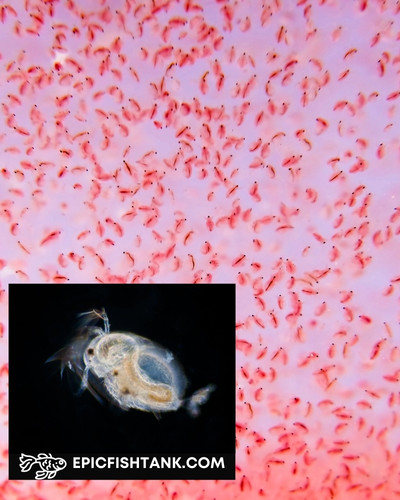
Moina are small freshwater crustaceans that are an excellent food source for small fish. They are rich in protein, vitamins, and minerals that support fish growth and coloration. Moina are easy to cultivate at home, and they have a longer lifespan than baby brine shrimp.
Moina are a nutritious and relatively easy-to-culture live food option for aquarium fish, particularly small fish and fish fry. However, they do require specific water conditions for optimal culturing and may be more challenging to harvest from the culture medium compared to other live food options.
Here are the Benefit and Drawbacks of using moina as live food:
| Benefits | Drawbacks |
| High Nutritional Value: Moina are rich in protein and other essential nutrients, making them a highly nutritious food source for fish. | Short Shelf Life: Like other live foods, moina have a relatively short shelf life and must be used quickly before they die off. |
| Easy to Digest: The small size and delicate nature of moina make them easy for fish to digest, especially for fry and juveniles. | Time-Consuming: Cultivating and harvesting moina can be time-consuming, especially if you are breeding fish on a large scale. |
| Promotes Growth: Due to their high nutritional value, moina can help to promote healthy growth and development in fish. | Risk of Contamination: If the moina culture is not kept clean and maintained properly, there is a risk of bacterial and fungal contamination. |
| Variety: Moina can add variety to a fish’s diet, which can help to prevent boredom and promote natural feeding behaviors. | Cost: The cost of setting up and maintaining a moina culture can add up over time, especially if you are breeding fish on a large scale. |
| Easy to Cultivate: Moina are relatively easy to cultivate and can be grown in a variety of containers and setups. | Environmental Impact: Like brine shrimp, over-harvesting of moina from natural habitats can have negative impacts on local ecosystems. |
| Can be Used as Starter Food: Moina are small enough to be used as starter food for very small fish and fry that may have trouble eating larger foods. | Limited Availability: Moina may not be as widely available as other live foods and may be more difficult to find at local pet stores. |
EpicFishTank Note:
In Southeast Asia, betta fish breeders primarily utilize daphnia and moina to expedite color mutation in fish.
This is because these microorganisms are rich in nutrients, containing approximately 45% protein, 4% fat, and 30% minerals. Additionally, daphnia and moina serve as excellent sources of vitamins, especially vitamins A, B1, and B2.
Bloodworms
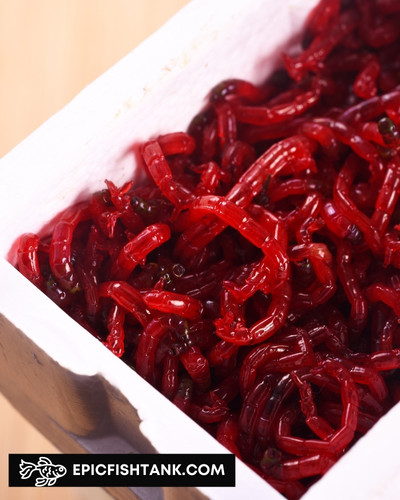
Bloodworms are the larvae of the midge fly and are a popular food source for aquarium fish. They are high in protein and provide essential nutrients for fish growth and coloration.
Bloodworms are available in freeze-dried or frozen form and are suitable for many types of fish, including discus and angelfish. Bloodworms are a popular live food option for aquarium fish, particularly carnivorous fish species.
Here are the Benefit and Drawbacks of using bloodworms as live food:
| Benefits | Drawbacks |
| High Nutritional Value: Bloodworms are rich in protein and other essential nutrients, making them a highly nutritious food source for fish. | Risk of Contamination: If the bloodworms are not handled and stored properly, there is a risk of bacterial and fungal contamination. |
| Easy to Digest: The small size and soft texture of bloodworms make them easy for fish to digest. | Short Shelf Life: Bloodworms have a relatively short shelf life and must be used quickly before they spoil. |
| Promotes Growth: Due to their high nutritional value, bloodworms can help to promote healthy growth and development in fish. | Cost: The cost of purchasing live or frozen bloodworms can add up over time, especially if you have a large number of fish to feed. |
| Variety: Bloodworms can add variety to a fish’s diet, which can help to prevent boredom and promote natural feeding behaviors. | Environmental Impact: Over-harvesting of bloodworms from natural habitats can have negative impacts on local ecosystems. |
| Can be Used as a Treat: Bloodworms can be used as an occasional treat for fish, which can help to add variety to their diet and promote natural feeding behaviors. | Risk of Overfeeding: Bloodworms are high in fat and can contribute to obesity and other health problems if overfed. |
| Widely Available: Live and frozen bloodworms are widely available at most pet stores and online retailers. | Not Suitable for All Fish: Bloodworms may not be suitable for all types of fish, especially those that have difficulty digesting high-fat foods. |
EpicFishTank Note:
While bloodworms are a valuable addition to a fish’s diet, they should not be the sole food source. Overfeeding or relying solely on bloodworms can lead to nutritional imbalances.
Additionally, always use high-quality, clean bloodworms from reputable sources to avoid introducing parasites or contaminants into your aquarium.
Daphnia Magna

Daphnia are small freshwater crustaceans that are a great food source for fish fry and adult fish. They are rich in protein, vitamins, and minerals that promote healthy growth and coloration.
Daphnia are easy to cultivate at home and are suitable for many types of fish, including molly, betta, tetras and gouramis. Daphnia are small freshwater crustaceans that are a popular and nutritious live food option for aquarium fish.
Here are the Benefit and Drawbacks of using daphnia as live food:
| Benefits | Drawbacks |
| High Nutritional Value: Daphnia are rich in protein and other essential nutrients, making them a highly nutritious food source for fish. | Short Shelf Life: Like other live foods, daphnia have a relatively short shelf life and must be used quickly before they die off. |
| Easy to Digest: The small size and delicate nature of daphnia make them easy for fish to digest, especially for fry and juveniles. | Risk of Contamination: If the daphnia culture is not kept clean and maintained properly, there is a risk of bacterial and fungal contamination. |
| Promotes Growth: Due to their high nutritional value, daphnia can help to promote healthy growth and development in fish. | Time-Consuming: Cultivating and harvesting daphnia can be time-consuming, especially if you are breeding fish on a large scale. |
| Variety: Daphnia can add variety to a fish’s diet, which can help to prevent boredom and promote natural feeding behaviors. | Cost: The cost of setting up and maintaining a daphnia culture can add up over time, especially if you are breeding fish on a large scale. |
| Can be Used as Starter Food: Daphnia are small enough to be used as starter food for very small fish and fry that may have trouble eating larger foods. | Environmental Impact: Like other live foods, over-harvesting of daphnia from natural habitats can have negative impacts on local ecosystems. |
| Easy to Cultivate: Daphnia are relatively easy to cultivate and can be grown in a variety of containers and setups. | Limited Availability: Daphnia may not be as widely available as other live foods and may be more difficult to find at local pet stores. |
Vinegar Eel
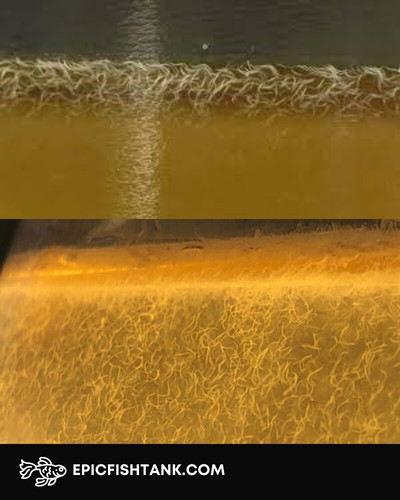
Vinegar eels are tiny nematodes that are a nutritious food source for fish fry. They are high in protein and other essential nutrients that promote healthy growth. Vinegar eels are easy to cultivate at home, and they have a long lifespan.
Vinegar eels are a small, free-living nematode that can be used as a live food source for aquarium fish.
Here are the Benefit and Drawbacks of using vinegar eels as live food:
| Benefits | Drawbacks |
| High Nutritional Value: Vinegar eels are rich in protein and other essential nutrients, making them a highly nutritious food source for fish. | Limited Availability: Vinegar eels may not be as widely available as other live foods and may be more difficult to find at local pet stores. |
| Easy to Digest: The small size and delicate nature of vinegar eels make them easy for fish to digest, especially for fry and juveniles. | Short Shelf Life: Like other live foods, vinegar eels have a relatively short shelf life and must be used quickly before they die off. |
| Promotes Growth: Due to their high nutritional value, vinegar eels can help to promote healthy growth and development in fish. | Time-Consuming: Cultivating and harvesting vinegar eels can be time-consuming, especially if you are breeding fish on a large scale. |
| Variety: Vinegar eels can add variety to a fish’s diet, which can help to prevent boredom and promote natural feeding behaviors. | Risk of Contamination: If the vinegar eel culture is not kept clean and maintained properly, there is a risk of bacterial and fungal contamination. |
| Can be Used as Starter Food: Vinegar eels are small enough to be used as starter food for very small fish and fry that may have trouble eating larger foods. | Cost: The cost of setting up and maintaining a vinegar eel culture can add up over time, especially if you are breeding fish on a large scale. |
| Easy to Cultivate: Vinegar eels are relatively easy to cultivate and can be grown in a variety of containers and setups. | Environmental Impact: There is no negative environmental impact associated with cultivating vinegar eels, as they can be grown in a controlled environment. |
EpicFishTank Note:
It is crucial to maintain the cleanliness of a vinegar eel culture to prevent bacterial and fungal contamination.
A vital note is to regularly check the culture for signs of contamination, such as off-odors, discoloration, or cloudiness, and promptly address any issues to ensure the health of the organisms and the safety of the fish being fed.
Micro Worms

Micro worms are small nematodes that are a great food source for fish fry. They are high in protein and other essential nutrients that promote healthy growth.
Micro worms are a small species of nematode that are a popular live food option for small fish and fish fry. Micro worms are easy to cultivate at home and are suitable for many types of fish, including, betta, guppies, killifish, and cichlids.
Here are the Benefit and Drawbacks of using micro worms as live food:
| Benefits | Drawbacks |
| High Nutritional Value: Micro worms are rich in protein and other essential nutrients, making them a highly nutritious food source for fish. | Limited Availability: Micro worms may not be as widely available as other live foods and may be more difficult to find at local pet stores. |
| Easy to Digest: The small size and delicate nature of micro worms make them easy for fish to digest, especially for fry and juveniles. | Short Shelf Life: Like other live foods, micro worms have a relatively short shelf life and must be used quickly before they die off. |
| Promotes Growth: Due to their high nutritional value, micro worms can help to promote healthy growth and development in fish. | Time-Consuming: Cultivating and harvesting micro worms can be time-consuming, especially if you are breeding fish on a large scale. |
| Variety: Micro worms can add variety to a fish’s diet, which can help to prevent boredom and promote natural feeding behaviors. | Risk of Contamination: If the micro worm culture is not kept clean and maintained properly, there is a risk of bacterial and fungal contamination. |
| Can be Used as Starter Food: Micro worms are small enough to be used as starter food for very small fish and fry that may have trouble eating larger foods. | Cost: The cost of setting up and maintaining a micro worm culture can add up over time, especially if you are breeding fish on a large scale. |
| Easy to Cultivate: Micro worms are relatively easy to cultivate and can be grown in a variety of containers and setups. | Environmental Impact: There is no negative environmental impact associated with cultivating micro worms, as they can be grown in a controlled environment. |
Infusoria
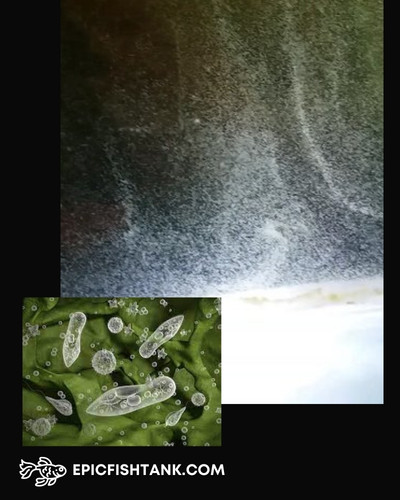
Infusoria is a mix of small aquatic organisms, including protozoans and bacteria, that are a great food source for fish fry. Infusoria are a type of microorganism that can be used as a live food source for small fish and fish fry.
They are high in protein and other essential nutrients that promote healthy growth. Infusoria is easy to cultivate at home, and they have a long lifespan.
Here are the Benefit and Drawbacks of using infusoria as live food:
| Benefits | Drawbacks |
| High Nutritional Value: Infusoria are rich in protein and other essential nutrients, making them a highly nutritious food source for fish. | Limited Availability: Infusoria may not be as widely available as other live foods and may be more difficult to find at local pet stores. |
| Easy to Digest: The small size and delicate nature of infusoria make them easy for fish to digest, especially for fry and juveniles. | Short Shelf Life: Like other live foods, infusoria have a relatively short shelf life and must be used quickly before they die off. |
| Promotes Growth: Due to their high nutritional value, infusoria can help to promote healthy growth and development in fish. | Time-Consuming: Cultivating and harvesting infusoria can be time-consuming, especially if you are breeding fish on a large scale. |
| Variety: Infusoria can add variety to a fish’s diet, which can help to prevent boredom and promote natural feeding behaviors. | Risk of Contamination: If the infusoria culture is not kept clean and maintained properly, there is a risk of bacterial and fungal contamination. |
| Can be Used as Starter Food: Infusoria are small enough to be used as starter food for very small fish and fry that may have trouble eating larger foods. | Cost: The cost of setting up and maintaining an infusoria culture can add up over time, especially if you are breeding fish on a large scale. |
| Easy to Cultivate: Infusoria are relatively easy to cultivate and can be grown in a variety of containers and setups. | Environmental Impact: There is no negative environmental impact associated with cultivating infusoria, as they can be grown in a controlled environment. |
Tubifex Worm

Tubifex worms are a popular food source for many types of fish, including catfish and loaches. They are high in protein and other essential nutrients that promote healthy growth.
Tubifex worms are a popular live food option for aquarium fish, particularly for bottom-feeding fish such as loaches and catfish. Tubifex worms are available in freeze-dried or frozen form and are easy to feed.
Here are the Benefit and Drawbacks of using Tubifex worms as live food:
| Benefits | Drawbacks |
| High Nutritional Value: Tubifex worms are rich in protein and other essential nutrients, making them a highly nutritious food source for fish. | Risk of Contamination: If the Tubifex worm culture is not kept clean and maintained properly, there is a risk of bacterial and fungal contamination. |
| Easy to Digest: The small size and soft texture of Tubifex worms make them easy for fish to digest. | Short Shelf Life: Tubifex worms have a relatively short shelf life and must be used quickly before they spoil. |
| Promotes Growth: Due to their high nutritional value, Tubifex worms can help to promote healthy growth and development in fish. | Cost: The cost of purchasing live or frozen Tubifex worms can add up over time, especially if you have a large number of fish to feed. |
| Variety: Tubifex worms can add variety to a fish’s diet, which can help to prevent boredom and promote natural feeding behaviors. | Environmental Impact: Over-harvesting of Tubifex worms from natural habitats can have negative impacts on local ecosystems. |
| Can be Used as a Treat: Tubifex worms can be used as an occasional treat for fish, which can help to add variety to their diet and promote natural feeding behaviors. | Risk of Overfeeding: Tubifex worms are high in fat and can contribute to obesity and other health problems if overfed. |
| Widely Available: Live and frozen Tubifex worms are widely available at most pet stores and online retailers. | Not Suitable for All Fish: Tubifex worms may not be suitable for all types of fish, especially those that have difficulty digesting high-fat foods. |
EpicFishTank Note:
It is essential to note that tubifex worms have a high-fat content and can lead to obesity and related health issues if fed excessively.
Consequently, they may not be an ideal food source for all fish species. Ensure that you research and provide a balanced diet suitable for the specific dietary needs of your fish to maintain their overall health and well-being.
Blackworm
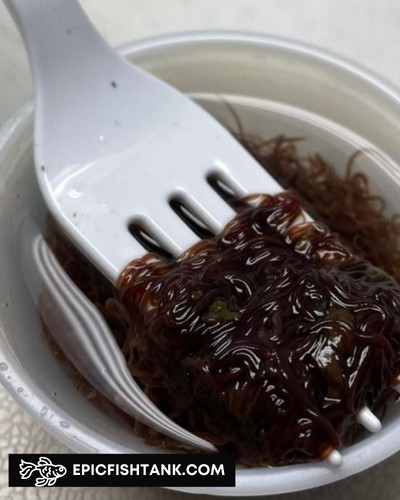
Blackworms are a popular food source for many types of fish, including discus and angelfish. They are high in protein and other essential nutrients that promote healthy growth.
Blackworms are a popular live food option for aquarium fish, particularly for bottom-feeding fish such as loaches and cichlids. Blackworms are available in freeze-dried or frozen form and are easy to feed.
Here are the Benefit and Drawbacks of using blackworms as live food:
| Benefits | Drawbacks |
| High Nutritional Value: Blackworms are rich in protein and other essential nutrients, making them a highly nutritious food source for fish. | Short Shelf Life: Like other live foods, blackworms have a relatively short shelf life and must be used quickly before they die off. |
| Easy to Digest: The small size and soft texture of blackworms make them easy for fish to digest. | Risk of Contamination: If the blackworm culture is not kept clean and maintained properly, there is a risk of bacterial and fungal contamination. |
| Promotes Growth: Due to their high nutritional value, blackworms can help to promote healthy growth and development in fish. | Cost: The cost of purchasing and maintaining a blackworm culture can add up over time, especially if you have a large number of fish to feed. |
| Variety: Blackworms can add variety to a fish’s diet, which can help to prevent boredom and promote natural feeding behaviors. | Environmental Impact: Over-harvesting of blackworms from natural habitats can have negative impacts on local ecosystems. |
| Can be Used as a Treat: Blackworms can be used as an occasional treat for fish, which can help to add variety to their diet and promote natural feeding behaviors. | Not Suitable for All Fish: Blackworms may not be suitable for all types of fish, especially those that have difficulty digesting high-fat foods. |
| Widely Available: Live and frozen blackworms are widely available at most pet stores and online retailers. | Time-Consuming: Cultivating and harvesting blackworms can be time-consuming, especially if you are breeding fish on a large scale. |
Grindal Worms

Grindal worms (Enchytraeus buchholzi) are a small species of worm that are an excellent food source for small and medium-sized fish.
They are typically around 3 to 4 mm in length and are easy to culture at home. Grindal worms are rich in protein and other essential nutrients that promote healthy growth in fish.
Here are the Benefit and Drawbacks of using Grindal worms as live food:
| Benefits | Drawbacks |
| High Nutritional Value: Grindal worms are rich in protein and other essential nutrients, making them a highly nutritious food source for fish. | Limited Availability: Grindal worms may not be as widely available as other live foods and may be more difficult to find at local pet stores. |
| Easy to Digest: The small size and soft texture of Grindal worms make them easy for fish to digest. | Short Shelf Life: Grindal worms have a relatively short shelf life and must be used quickly before they die off. |
| Promotes Growth: Due to their high nutritional value, Grindal worms can help to promote healthy growth and development in fish. | Cost: The cost of purchasing and maintaining a Grindal worm culture can add up over time, especially if you have a large number of fish to feed. |
| Variety: Grindal worms can add variety to a fish’s diet, which can help to prevent boredom and promote natural feeding behaviors. | Time-Consuming: Cultivating and harvesting Grindal worms can be time-consuming, especially if you are breeding fish on a large scale. |
| Can be Used as a Treat: Grindal worms can be used as an occasional treat for fish, which can help to add variety to their diet and promote natural feeding behaviors. | Risk of Contamination: If the Grindal worm culture is not kept clean and maintained properly, there is a risk of bacterial and fungal contamination. |
Mosquito Larvae
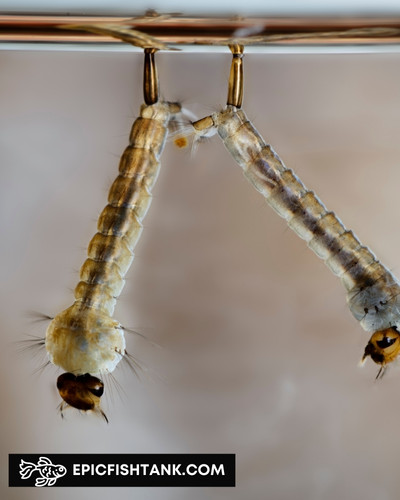
Mosquito larvae are a common live food source for many aquarium fish. They are high in protein and other essential nutrients that promote healthy growth.
Mosquito larvae are easy to cultivate at home, but it is important to ensure that they are free of any diseases or parasites.
Here are the Benefit and Drawbacks of using mosquito larvae as live food:
| Benefits | Drawbacks |
| High Nutritional Value: Mosquito larvae are rich in protein and other essential nutrients, making them a highly nutritious food source for fish. | Risk of Disease: Mosquito larvae can carry diseases that may be harmful to fish, so it’s important to only use larvae from a trusted source. |
| Easy to Digest: The small size and delicate nature of mosquito larvae make them easy for fish to digest, especially for fry and juveniles. | Short Shelf Life: Mosquito larvae have a relatively short shelf life and must be used quickly before they die off. |
| Promotes Growth: Due to their high nutritional value, mosquito larvae can help to promote healthy growth and development in fish. | Risk of Overfeeding: Mosquito larvae can contribute to obesity and other health problems if overfed. |
| Variety: Mosquito larvae can add variety to a fish’s diet, which can help to prevent boredom and promote natural feeding behaviors. | Risk of Contamination: If the mosquito larvae culture is not kept clean and maintained properly, there is a risk of bacterial and fungal contamination. |
| Can be Used as a Treat: Mosquito larvae can be used as an occasional treat for fish, which can help to add variety to their diet and promote natural feeding behaviors. | Environmental Impact: Mosquito larvae can be sourced from natural habitats, but over-harvesting can have negative impacts on local ecosystems. |
| Widely Available: Mosquito larvae are widely available in warmer climates or during the summer months, as mosquitoes thrive in warmer temperatures. | Not Suitable for All Fish: Mosquito larvae may not be suitable for all types of fish, especially those that have difficulty digesting high-fat foods. |
EpicFishTank Note:
In some regions, cultivating mosquito larvae may be discouraged or even illegal due to the potential risk of contributing to mosquito-borne disease outbreaks.
Always check local regulations before attempting to breed mosquito larvae at home.
Insect Type Live Food
Many predatory fish eagerly consume insects, making them a worthwhile alternative live food option. It’s worth trying various insects such as Wingless Fruit Flies, maggots, mealworms, and crickets to diversify their diet.
Younger predatory fish often have a broader palate and can be expected to eat live brine shrimp, daphnia, mosquito larvae, and bloodworms. Experimenting with different live foods helps ensure a balanced and nutritious diet for your predatory fish, catering to their specific needs and preferences.
In this section, we will delve into various insect-type live food options for predatory fish, highlighting the benefits of including these nutritious treats in their diet.
Wingless Fruit Flies
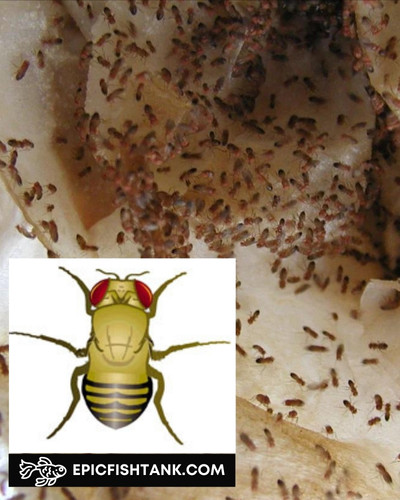
Wingless fruit flies are a great food source for small fish and fish fry. They are high in protein and other essential nutrients that promote healthy growth.
Wingless fruit flies are easy to cultivate at home and are suitable for many types of fish, including killifish and tetras.
Here are the Benefit and Drawbacks of using wingless fruit flies as live food:
| Benefits | Drawbacks |
| High Nutritional Value: Wingless fruit flies are rich in protein and other essential nutrients, making them a highly nutritious food source for fish. | Limited Availability: Wingless fruit flies may not be as widely available as other live foods and may be more difficult to find at local pet stores. |
| Easy to Digest: The small size and soft texture of wingless fruit flies make them easy for fish to digest. | Short Shelf Life: Wingless fruit flies have a relatively short shelf life and must be used quickly before they die off. |
| Promotes Growth: Due to their high nutritional value, wingless fruit flies can help to promote healthy growth and development in fish. | Cost: The cost of purchasing and maintaining a wingless fruit fly culture can add up over time, especially if you have a large number of fish to feed. |
| Variety: Wingless fruit flies can add variety to a fish’s diet, which can help to prevent boredom and promote natural feeding behaviors. | Time-Consuming: Cultivating and harvesting wingless fruit flies can be time-consuming, especially if you are breeding fish on a large scale. |
| Can be Used as a Treat: Wingless fruit flies can be used as an occasional treat for fish, which can help to add variety to their diet and promote natural feeding behaviors. | Risk of Contamination: If the wingless fruit fly culture is not kept clean and maintained properly, there is a risk of bacterial and fungal contamination. |
Maggot BSF
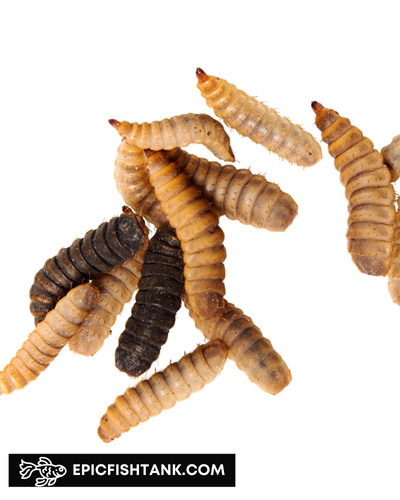
Maggots are the larvae of the black soldier fly and are a nutritious food source for many types of fish, including bettas and guppies. They are high in protein and other essential nutrients that promote healthy growth.
Maggots are easy to cultivate at home, but it is important to ensure that they are free of any diseases or parasites.
Here are the Benefit and Drawbacks of using maggots as live food:
| Benefits | Drawbacks |
| High Nutritional Value: Maggots are rich in protein and other essential nutrients, making them a potentially nutritious food source for fish. | Risk of Contamination: Maggots are often associated with decomposing organic matter and unsanitary conditions, which can lead to bacterial and fungal contamination. |
| Easy to Digest: The small size and soft texture of maggots make them easy for fish to digest. | Health Risks: Handling and using maggots can pose health risks, including the risk of bacterial and fungal infections. |
| Promotes Growth: Due to their high nutritional value, maggots can help to promote healthy growth and development in fish. | Ethical Concerns: Using maggots as live food for fish may be considered unethical by some individuals, as maggots are often associated with unsanitary conditions and decomposition. |
| Variety: Maggots can add variety to a fish’s diet, which can help to prevent boredom and promote natural feeding behaviors. | Environmental Impact: Maggot farming or harvesting from natural habitats can have negative impacts on local ecosystems. |
| Can be Used as a Treat: Maggots can be used as an occasional treat for fish, which can help to add variety to their diet and promote natural feeding behaviors. | Limited Availability: Maggots may not be as widely available as other types of live food and may be more difficult to find at local pet stores. |
Mealworm
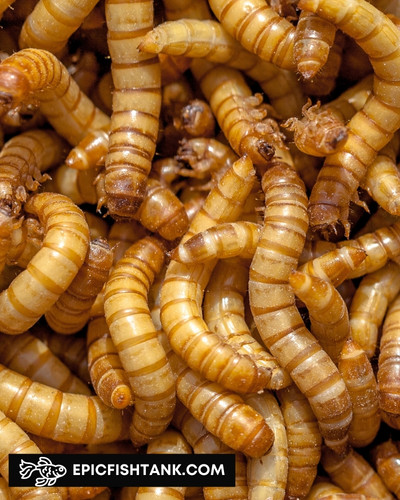
Mealworms are the larvae of darkling beetles and are a popular food source for many types of fish, particularly insectivorous fish such as bettas and gouramis.
They are high in protein and other essential nutrients that promote healthy growth. Mealworms are available in freeze-dried or live form and are easy to feed.
Here are the Benefit and Drawbacks of using mealworms as live food:
| Benefits | Drawbacks |
| High Nutritional Value: Mealworms are rich in protein and other essential nutrients, making them a highly nutritious food source for fish. | Risk of Choking: Mealworms can be too large for small fish and fry, and there is a risk of choking if the worms are not chopped up into smaller pieces. |
| Easy to Digest: The small size and soft texture of mealworms make them easy for fish to digest. | Short Shelf Life: Mealworms have a relatively short shelf life and must be used quickly before they die off. |
| Promotes Growth: Due to their high nutritional value, mealworms can help to promote healthy growth and development in fish. | Risk of Overfeeding: Mealworms are high in fat and can contribute to obesity and other health problems if overfed. |
| Variety: Mealworms can add variety to a fish’s diet, which can help to prevent boredom and promote natural feeding behaviors. | Environmental Impact: Over-harvesting of mealworms from natural habitats can have negative impacts on local ecosystems. |
| Can be Used as a Treat: Mealworms can be used as an occasional treat for fish, which can help to add variety to their diet and promote natural feeding behaviors. | Not Suitable for All Fish: Mealworms may not be suitable for all types of fish, especially those that have difficulty digesting high-fat foods. |
| Widely Available: Live and dried mealworms are widely available at most pet stores and online retailers. | Cost: The cost of purchasing and maintaining a mealworm culture can add up over time, especially if you have a large number of fish to feed. |
Crickets
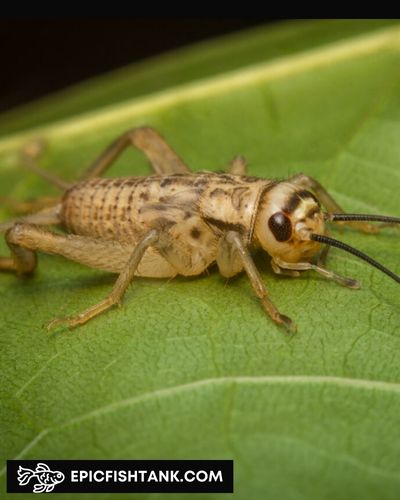
Crickets can be a nutritious live food option for larger, predatory fish species, providing essential protein and nutrients. Ensure the crickets are appropriately sized and that your fish will accept them as a food source.
Introduce crickets alongside a varied diet of other live, frozen, or dry foods to maintain a balanced and healthy diet for your fish.
Here are the Benefit and Drawbacks of using Crickets as live food:
| Benefits | Drawbacks |
|---|---|
| High Nutritional Value: Crickets are rich in protein and essential nutrients, making them a highly nutritious food source for fish. | Limited Availability: Crickets may not be as widely available as other live foods and might be more challenging to find at local pet stores. |
| Easy to Digest: Crickets have an exoskeleton that is relatively easy for fish to digest, especially when they are appropriately sized. | Size Variation: Crickets come in various sizes, which can make it difficult to find the right size for smaller fish species. |
| Promotes Growth: The high nutritional value of crickets helps support healthy growth and development in fish. | Cost: Purchasing and maintaining a cricket supply can be expensive, especially if you have a large number of fish to feed. |
| Variety: Crickets add variety to a fish’s diet, helping to prevent boredom and promote natural feeding behaviors. | Time-Consuming: Cultivating and harvesting crickets can be time-consuming, particularly for large-scale fish breeding. |
| Can be Used as a Treat: Crickets can serve as an occasional treat for fish, adding variety to their diet and encouraging natural feeding behaviors. | Environmental Impact: Importing crickets from other regions may have a negative environmental impact, but this can be mitigated by purchasing locally bred crickets. |
Predatory and Aggressive Aquarium Fish That Eat Other Fish
Arowana, Snakehead, Peacock Bass, Oscar, Anglefish, Leopard Bush Fish, Bichir, Red Devil, Jack Dempsey, Jaguar Fish, Texas Cichild, Red Terror, and Flowerhorn are just a few examples of popular predator fish that require a specialized diet to maintain their health and vitality. While traditional fish food can be nutritious, these predators often crave a more varied and stimulating diet.
Frequently, these fish coexist peacefully in community tanks alongside smaller species when they are young, and issues are typically minimal.
Nonetheless, as they mature into aggressive ambush predators, you may observe the disappearance of some smaller tank mates. To prevent this, it is advised not to house these fish with neon tetras and other small species.
💡Live food provides a great opportunity to give them a taste of their natural diet, while also promoting their predatory instincts and overall well-being.
In this section, we’ll explore some of the best alternative live food options for predator fish and discuss how they can benefit from incorporating these tasty treats into their diet.
Earthworms
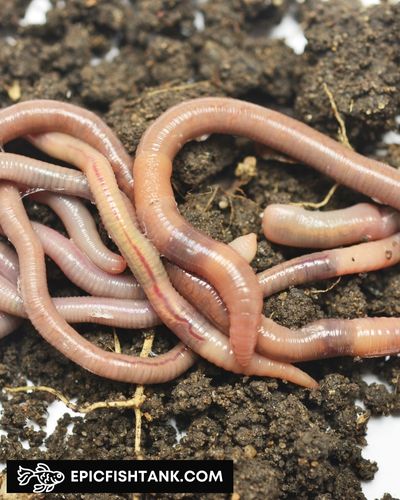
Almost all predatory fish consume earthworms, which is why they are popular bait among anglers. Although you can find earthworms in gardens, they are also available for purchase at bait shops.
While earthworms offer nutritional value and are unlikely to carry parasites harmful to tropical fish, they are not entirely risk-free. If they come from areas where pesticides or herbicides are used, they may carry these chemicals in the soil within their guts, potentially harming your fish. Avoid collecting earthworms from gardens treated with such chemicals.
Here are the Benefit and Drawbacks of using Earthworms as predator live food:
| Benefits of Using Earthworms as Live Food | Drawbacks of Using Earthworms as Live Food |
|---|---|
| High Nutritional Value: Earthworms are rich in protein and minerals, making them a highly nutritious food source for fish. | Limited Availability: Earthworms may not be as widely available as other live foods and might be more challenging to find at local pet stores. |
| Easy to Digest: Earthworms are soft-bodied and easily digestible for most predatory fish species. | Risk of Contamination: Earthworms collected from gardens treated with pesticides or herbicides may contain harmful chemicals that could pose risks to your fish. |
| Promotes Growth: The high nutritional value of earthworms contributes to healthy growth and development in fish. | Time-Consuming: Cultivating and harvesting earthworms can be time-consuming, particularly for large-scale fish breeding. |
| Variety: Earthworms add variety to a fish’s diet, helping to prevent boredom and promote natural feeding behaviors. | Environmental Impact: Collecting earthworms from the wild may have a negative impact on the local ecosystem. |
| Can be Used as a Treat: Earthworms can serve as an occasional treat for fish, adding variety to their diet and encouraging natural feeding behaviors. | Cost: Purchasing and maintaining an earthworm supply can be expensive, especially if you have a large number of fish to feed. |
| Easy to Cultivate: Earthworms can be relatively easy to cultivate and breed in various containers and setups, such as worm bins or compost piles. | Size Variation: Earthworms come in various sizes, which can make it difficult to find the right size for smaller fish species. |
River Shrimps

River shrimps serve as another viable option, though they should be fed sparingly. Although they are unlikely to harbor parasites, they may contain high levels of thiaminase.
Overfeeding river shrimps can lead to vitamin B1 deficiency in your fish. Nevertheless, river shrimps are an excellent food choice for acclimating newly acquired predatory fish that are not yet accustomed to consuming dead or frozen foods.
Here are the Benefit and Drawbacks of using River Shrimps as predator live food:
| Benefits | Drawbacks |
|---|---|
| High Nutritional Value: River shrimps are rich in protein and other essential nutrients, making them a highly nutritious food source for fish. | Thiaminase Content: River shrimps may contain high levels of thiaminase, which, if used excessively, could cause a vitamin B1 deficiency in your fish. |
| Easy to Digest: River shrimps are soft-bodied and easily digestible for most predatory fish species. | Limited Availability: River shrimps may not be as widely available as other live foods and might be more challenging to find at local pet stores. |
| Promotes Growth: The high nutritional value of river shrimps contributes to healthy growth and development in fish. | Risk of Contamination: Wild-caught river shrimps may contain parasites or pollutants that could pose risks to your fish. |
| Variety: River shrimps add variety to a fish’s diet, helping to prevent boredom and promote natural feeding behaviors. | Cost: Purchasing and maintaining a river shrimp supply can be expensive, especially if you have a large number of fish to feed. |
| Can be Used as a Treat: River shrimps can serve as an occasional treat for fish, adding variety to their diet and encouraging natural feeding behaviors. | Size Variation: River shrimps come in various sizes, which can make it difficult to find the right size for smaller fish species. |
FAQs
Got some questions about feeding your fish live food? We’ve got you covered! Check out these frequently asked questions to learn more about incorporating live food into your fish’s diet.
Where to Find Live Fish Food for Sale?
Here are two popular online sources where you can find live fish food for sale:
💡AquaBid
AquaBid is an online marketplace for aquarium enthusiasts to buy and sell aquatic goods, including live fish food. They have a dedicated section for live fish food where you can find a variety of options, including brine shrimp, daphnia, and worms.
The site works on an auction-style bidding system, so you can potentially find some great deals.
Link: https://www.aquabid.com/cgi-bin/auction/auction.cgi?foodl
💡Amazon
Amazon is a popular online marketplace that offers a wide range of live fish food for sale. You can find products like live brine shrimp, daphnia, worms, and other small aquatic creatures that are ideal for feeding your fish.
Amazon offers competitive pricing and fast shipping, making it a convenient option for purchasing live fish food.
Link: https://amzn.to/3LBe5lY
💡eBay
eBay is another online marketplace where you can find live fish food for sale. They have a wide selection of options, including live brine shrimp, blackworms, and microworms.
You can filter your search by type of food, price range, and location to find the best options for your needs. Plus, many sellers offer free shipping on their products.
EpicFishTank Note:
When shopping online, it’s important to read reviews, compare prices, and check the seller’s reputation to ensure that you get the best quality products at a fair price.
Should You Stock Fish That Eat Other Fish?
Owning any fish, even wild ones, is possible in a home aquarium if you possess the right experience and setup. However, this is where challenges arise. Experienced aquarists understand how to manage aggressive fish, ensuring proper care and suitable conditions, while avoiding species they cannot care for appropriately.
In contrast, beginners may encounter unforeseen behaviors or lack proper guidance from pet store staff. Thus, researching fish before introducing them to your home is crucial.
Many seasoned fishkeepers enjoy nurturing predatory fish, as they offer a more interactive experience and possibly exhibit more personality compared to typical community tanks due to their feeding needs.
EpicFishTank Note:
Ultimately, the choice is yours. The key is to ensure that you provide the right environment and compatible tank mates for the fish you choose to keep.
Final Words
Incorporating live food into your fish’s diet can provide them with essential nutrients, enhance their natural behaviors, and give them a varied and exciting diet.
From crunchy insects to wriggling worms, there’s something for every fish. Remember to do your research and buy from a reputable source to ensure the live food is safe for your fish to consume.
So why not add some variety to your fish’s diet and give them a feeding frenzy they won’t forget? Happy feeding!
Reference
- quod.lib.umich.edu | Culturing Daphnia for fish food
- Academia.edu | Importance of Live Fish Feed in Aquaculture
- Ncbi.nlm.nih.gov | Enhancement of Live Food Nutritional Status with Essential Nutrients for Improving Aquatic Animal Health: A Review
- Fisheries.tamu.edu | Understanding Fish Nutrition, Feeds, and Feeding
Time for a coffee break! With your support, We can keep working hard and creating fantastic content. #let's make it happen!
Author
Reza is a digital marketer and an avid freshwater aquarist. He's been keeping fish tanks for more than 10 years and has always been fascinated by the delicate balance of life in water.
Reza loves to share his knowledge about both digital marketing and fishkeeping with others, and he is always happy to help new aquarists get started in this rewarding hobby.
Wibisono is a freshwater fish breeder who raises and breeds different species of ornamental fish like betta, guppy, flowerhorn, and goldfish. He has been in the business since 2018 and exports his fish to different countries. He is committed to providing high-quality and healthy fish to his customers.

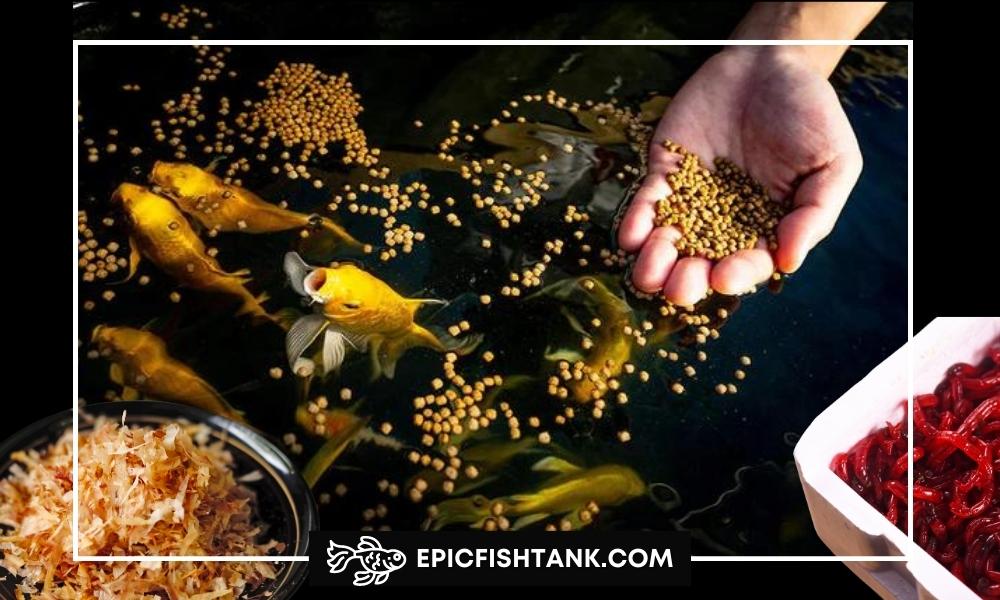
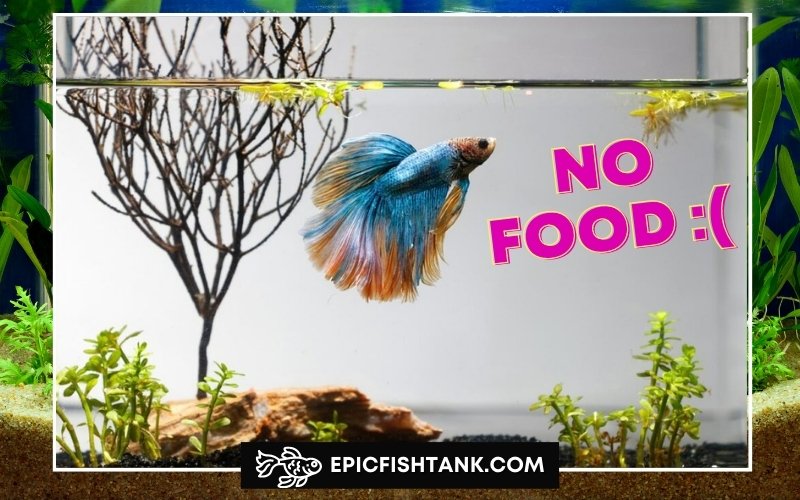
Leave a Reply